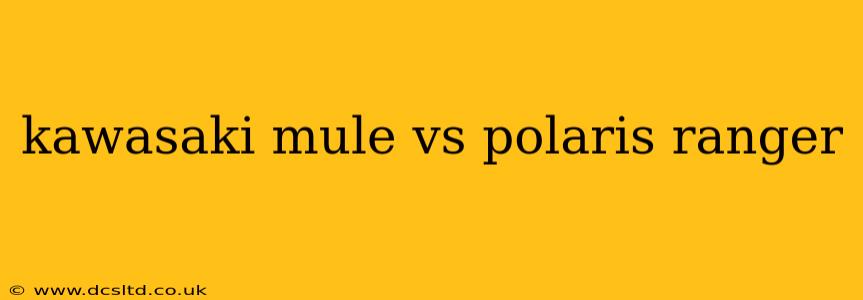Choosing between a Kawasaki Mule and a Polaris Ranger can feel like navigating a minefield of specs and features. Both are industry giants in the utility vehicle (UTV) market, offering a range of models designed for various tasks and terrains. This in-depth comparison will help you determine which machine best suits your needs and preferences. We'll explore key differences, highlighting strengths and weaknesses to empower you to make an informed decision.
What are the Key Differences Between Kawasaki Mules and Polaris Rangers?
The core difference boils down to design philosophy and target audience. Kawasaki Mules often prioritize durability and straightforward functionality, making them excellent workhorses for demanding jobs. Polaris Rangers, while also robust, tend to lean towards a more versatile and often more comfortable riding experience, catering to both work and recreational use.
This translates into tangible differences:
- Payload and Towing Capacity: Generally, Mule models offer impressive payload and towing capacities, excelling in heavy-duty applications. Polaris Rangers, while capable, may have slightly lower capacities in certain models, prioritizing maneuverability and comfort.
- Engine and Transmission: Both brands offer a variety of engine sizes and transmission types (automatic, manual). However, the specific offerings and power outputs vary considerably across models within each brand. Direct comparison requires specifying the exact Mule and Ranger models being considered.
- Ride and Handling: Rangers often boast more advanced suspension systems, resulting in a smoother, more comfortable ride, particularly on rough terrain. Mules usually prioritize ruggedness and stability over plushness.
- Features and Technology: Polaris often incorporates more advanced technology and features, such as electronic power steering, sophisticated infotainment systems, and various drive modes. While Mules are steadily incorporating new technologies, they traditionally focus on fundamental functionality.
- Price: The price range for both brands overlaps significantly, but generally, feature-rich Ranger models may sit at a higher price point than comparable Mule models.
What are the Pros and Cons of Kawasaki Mules?
Pros:
- Exceptional Durability and Reliability: Mules are known for their toughness and ability to withstand harsh conditions.
- High Payload and Towing Capacity: Ideal for heavy-duty work, hauling significant loads, and towing heavy trailers.
- Simple and User-Friendly Design: Easy to operate and maintain, minimizing complexity.
- Generally More Affordable: Entry-level Mule models are often priced more competitively than comparable Rangers.
Cons:
- Less Comfortable Ride: Suspension systems are typically less sophisticated than those in Polaris Rangers.
- Fewer Amenities and Features: Technology and comfort features are generally less advanced.
- Less Versatile: Primarily geared towards work, with less emphasis on recreational use.
What are the Pros and Cons of Polaris Rangers?
Pros:
- Comfortable Ride and Handling: Advanced suspension and steering systems provide a smoother, more enjoyable ride.
- Wide Range of Models and Features: Options cater to a diverse range of needs and preferences, from work to recreation.
- More Advanced Technology: Features like electronic power steering, sophisticated infotainment systems, and various drive modes enhance the driving experience.
- Greater Versatility: Suitable for both work and recreational activities.
Cons:
- Potentially Higher Price: Feature-rich models can be more expensive than comparable Mules.
- Potentially Less Durable: While still robust, some Ranger models may not match the sheer durability of some Mule models.
- More Complex Mechanics: Greater complexity can make maintenance and repair slightly more challenging.
Which UTV is Best for My Needs?
The "best" UTV depends entirely on your priorities and intended use.
-
Choose a Kawasaki Mule if: You prioritize durability, heavy-duty hauling and towing capabilities, simplicity, and affordability above all else. Your primary use will be demanding work tasks.
-
Choose a Polaris Ranger if: You need a versatile machine that handles both work and recreational tasks, desire a more comfortable and technologically advanced ride, and are willing to pay a potentially higher price.
How Do Kawasaki Mule and Polaris Ranger Compare in Terms of Maintenance?
Both brands require regular maintenance to ensure optimal performance and longevity. The complexity of the maintenance schedules can vary depending on the specific model. Generally, Mules, due to their simpler design, might have slightly less complex maintenance routines. However, consulting the owner's manual for your specific model is crucial for both brands.
What are the Common Problems Associated with Kawasaki Mules and Polaris Rangers?
Like any machinery, both Kawasaki Mules and Polaris Rangers can experience issues. Common problems can vary by model year and specific components. Thorough research specific to the model year you're considering is advisable. Online forums and owner communities are valuable resources for identifying potential problems and maintenance tips.
This comparison provides a general overview. For a truly informed decision, meticulously research the specific models within each brand that align with your requirements and budget. Test driving both a Mule and a Ranger is strongly recommended to experience the differences firsthand.
